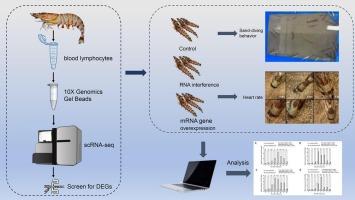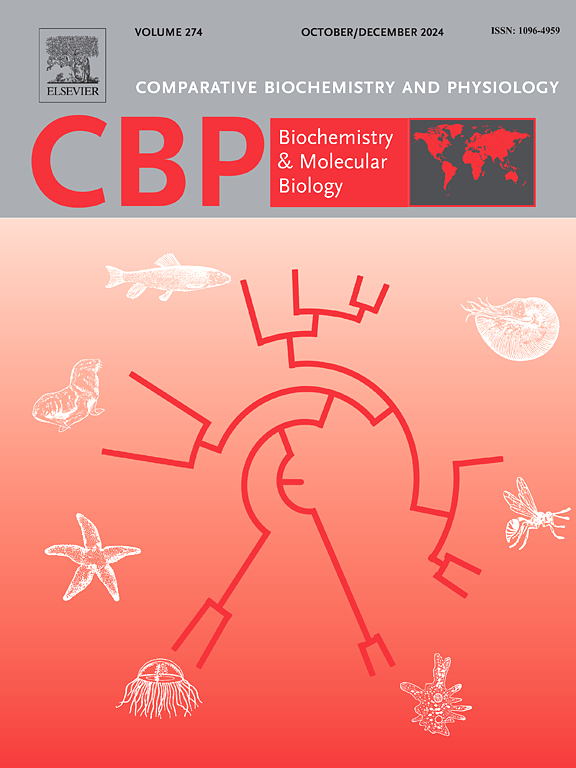甲壳类心脏活性肽(CCAP)负向调节日本对虾(Penaeus japonicus)潜沙行为。
IF 1.8
3区 生物学
Q4 BIOCHEMISTRY & MOLECULAR BIOLOGY
Comparative Biochemistry and Physiology B-Biochemistry & Molecular Biology
Pub Date : 2025-08-12
DOI:10.1016/j.cbpb.2025.111143
引用次数: 0
摘要
日本对虾(Penaeus japonicus)表现出沙潜行为。这种行为的遗传控制机制尚不清楚,尽管先前的单细胞转录组测序表明甲壳类心脏活性肽(CCAP)可能参与其中。本研究克隆了黑虾CCAP前体cDNA (Pj-CCAP)。预测该基因可翻译成4个相关肽和1个成熟肽(PFCNAFTGC-NH2),与甲壳类动物和昆虫高度相似。预测的Pj-CCAP本身在其他甲壳类动物中高度保守。RT-qPCR和原位杂交分析显示Pj-CCAP在肌肉组织中表达最高。采用RNA干扰和基因过表达的方法研究Pj-CCAP表达与对虾潜沙行为的关系。结果表明,在处理后6 h, RNA干扰组的沙潜率显著低于对照组,而RNA干扰对虾的心率也显著低于对照组,但在处理后12 h内恢复到基线水平。过表达导致了较低的潜沙率和短暂的心率增加。结果表明,Pj-CCAP对黑虾潜沙行为具有潜在的负调控作用,可能在调节黑虾生理节律和行为模式方面发挥重要作用。本文章由计算机程序翻译,如有差异,请以英文原文为准。

Crustacean cardioactive peptide (CCAP) negatively regulates sand-diving behaviour in kuruma shrimp, Penaeus japonicus
Kuruma shrimp (Penaeus japonicus) exhibits sand-diving behaviour. The genetic control mechanism of this behaviour is still unclear, although previous single-cell transcriptome sequencing suggests that crustacean cardioactive peptide (CCAP) may be involved. In this study, we cloned the CCAP precursor cDNA (Pj-CCAP) in kuruma shrimp. It was predicted that the gene can be translated into four related peptides and one mature peptide (PFCNAFTGC-NH2), and is highly similar to crustaceans and insects. The predicted Pj-CCAP itself is highly conserved in other crustaceans. RT-qPCR and in situ hybridization analysis showed that Pj-CCAP was most highly expressed in muscle tissue. RNA interference and gene overexpression were used to assess the relationship between Pj-CCAP expression and sand-diving behaviour of shrimp. The results showed that at 6 h post-treatment, the sand-diving rate in the RNA interference group was significantly lower than that in the control group, while the heart rate of shrimp subjected to RNA interference was also significantly, but recovered to baseline levels within 12 h post-treatment. Overexpression resulted in a lower sand diving rate, and a transient increase in heart rate. The results suggest that Pj-CCAP is potentially a negative regulator of sand diving behaviour of kuruma shrimp, and may have an important role in regulating its physiological rhythms and behavioural patterns.
求助全文
通过发布文献求助,成功后即可免费获取论文全文。
去求助
来源期刊
CiteScore
4.60
自引率
4.50%
发文量
77
审稿时长
22 days
期刊介绍:
Comparative Biochemistry & Physiology (CBP) publishes papers in comparative, environmental and evolutionary physiology.
Part B: Biochemical and Molecular Biology (CBPB), focuses on biochemical physiology, primarily bioenergetics/energy metabolism, cell biology, cellular stress responses, enzymology, intermediary metabolism, macromolecular structure and function, gene regulation, evolutionary genetics. Most studies focus on biochemical or molecular analyses that have clear ramifications for physiological processes.

 求助内容:
求助内容: 应助结果提醒方式:
应助结果提醒方式:


